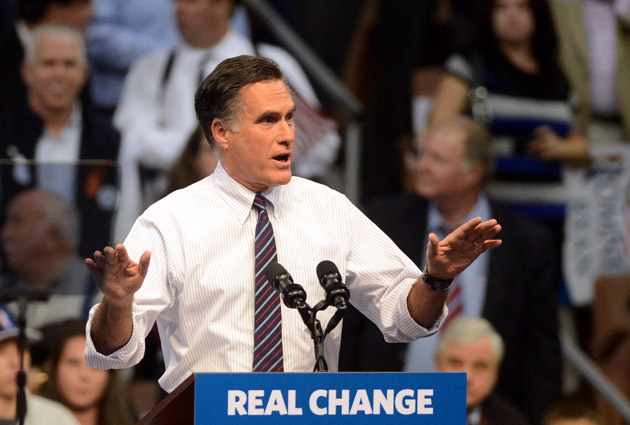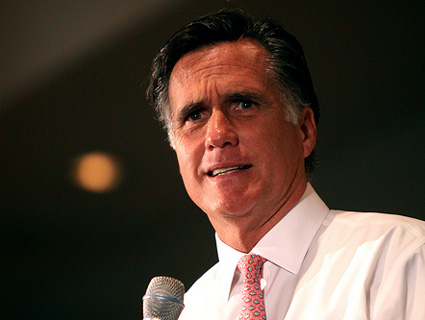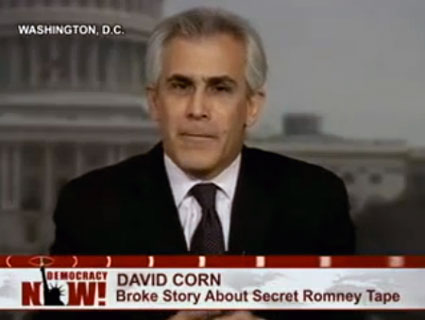
As 2012 draws to a close, many year-end reviews of the election season have focused on September 17, the day Mother Jones released the 47 percent video that captured Mitt Romney at a private fundraiser. That moment, when millions of Americans saw the candidate denigrating nearly half the electorate as “victims” who do not take “personal responsibility and care for their lives,” is widely seen as having upended the campaign. But the path to the scoop began months earlier, with a story about aborted fetuses.
Early on in the election season, Mother Jones had made a decision to look closely at Mitt Romney’s record as a businessman—a record the campaign was promoting as a key reason why voters should choose him. As I dug into the history of Bain Capital, the private equity firm Romney had founded and managed, I found out about an investment it had made in Stericycle, a medical-waste disposal firm that in more recent years had been attacked by anti-abortion groups for disposing of aborted fetuses from family planning clinics. I obtained an electronic pile of documents related to the deal, including filings Bain had made with the Securities and Exchange Commission. Romney was listed as an active participant in the Stericycle investment, which occurred in November 1999. This fact was significant; it undercut the claim that Romney had departed Bain in early 1999 to run the Winter Olympics, and had nothing to do with the firm’s actions after that point, including investments that relocated American jobs.
On July 2, I posted a story on the candidate’s connection to Stericyle, reporting that Bain had filed SEC documents—including one signed by Romney—designating Romney as an active participant in the deal in late 1999. The story made news, and soon other outlets followed up.
A few days later, I received an email from James Carter, a freelance researcher who had information to share. (He didn’t mention he was the grandson of President Jimmy Carter and possessed a deep personal motive for unearthing material on Romney, who routinely disparaged his grandfather. I wouldn’t learn of his relationship to the former president until early September, when Carter and I met at the Democratic convention in Charlotte.) Carter tipped me off to documents about a Bain affiliate’s investment in a Chinese firm named Global-Tech Appliances, which outsourced manufacturing for US corporations including Sunbeam and Hamilton Beach. The Global-Tech deal had occurred before Romney left Bain for the Winter Olympics.
I investigated further and broke the story on July 11.
On the campaign trail in February, I noted, Romney had proclaimed, “We will not let China continue to steal jobs from the United States of America.” Years earlier, though, he had bet on outsourcing.
There were thousands of pages of SEC documents to review. I discovered that a Bain affiliate wholly owned by Romney had invested tens of millions of dollars in a pair of companies that pioneered the outsourcing of high-tech manufacturing to Mexico, China, and elsewhere. These investments had originated before Romney left Bain for Utah.
On August 24, days before the Republican convention was to begin, Carter sent me a link to a YouTube video. It seemed to show Mitt Romney talking about a trip he had taken to China to buy a factory. Romney noted that the facility employed thousands of young women working long hours each day for “a pittance” and living “twelve girls per room.” The factory had fences and guard towers—not to keep the workers in, he was told, but to prevent job-seekers from sneaking in and joining the work force. For Romney, the point was not the harsh conditions faced by the Chinese workers but the wonders of the United States. He went on: “The Bain partner I was with turned to me and said, ‘You know, 95 percent of life is settled if you are born in America. This is an amazing land.'” A title at the end of the clip said it had been recorded at a $50,000-a-plate fundraiser, but there was no information about when or precisely where, or who had shot and posted the video.
The clip had been knocking around in the Internet for several months. Someone using the handle RomneyExposed had uploaded it along with a few other snippets that seemed to come from the same event. The images were disguised; these clips were essentially audio files and impossible to verify. The China remarks had also been posted on a fake YouTube account under the name of Rachel Maddow; the MSNBC host asked YouTube to shut down this channel, but she did link to the video on her website. After that, every so often a blogger would rediscover this clip, and in late August, someone posted it in both the HuffingtonPost comments section and on the liberal Daily Kos website. Yet its origins remained a mystery: Carter told me he’d found it through a simple YouTube search and didn’t know anything else about it. At my urging, he started digging.
On August 27—the day before the Republican convention was to open—a new YouTube account set up by “Anne Onymous” uploaded some of the clips. Carter discovered that this channel was linked to a Twitter account and sent the owner a private message. He didn’t learn the person’s identity nor any more detail about the China video, but informed me that the source “would like to get in touch with you.”
After a series of messages back and forth, “Anne Onymous” agreed to send me the entire video recording of this Romney fundraiser. He noted that the video was about an hour long, but he would not say where or when it had been shot. He asked that it not be released in any version that would show the faces of others in the room.
I told A.O. that I would not use any of the footage without consulting him, for it was clear that he wanted to preserve his anonymity. I emailed Carter, “I have made contact and am working something out. Will keep you posted.”
For several days, the source and I went back and forth. The file was too large to email. A.O. offered to ship it via overnight mail on Monday, September 3. I asked if he would send it through a file-transfer website. Yes, he said. But a few hours later, he seemed to be having second thoughts. I worried that he’d disappear.
I emphasized, as I had throughout, that I would handle the story responsibly and would not reveal his identity. He proposed obscuring the video so no one but Romney would be recognizable before sharing it with me. His aim was to keep the focus on the candidate’s words, not the location of the event or the guests.
I suggested A.O. let me view the video and then we would discuss what to do. Nothing, I said, would be done with the video without his approval.
That was finally good enough for him: A.O. told me the video would be sent via regular first-class mail from a city other than where he lived. It should arrive, he said, in several days. He said that he was entrusting me with it because of my previous work on Romney’s years at Bain.
In Charlotte, while covering the Democratic convention, I counted the hours as my colleagues in DC lay in wait for the mailman each afternoon. I maintained contact with A.O, who told me what to look for on the video: Romney impersonating Henry Kissinger, Romney saying that Palestinians didn’t want peace in the Middle East, and Romney declaring that 47 percent of Americans believe they are entitled to food, healthcare, and housing.
The package arrived on September 10. I was back from Charlotte and watched it immediately. There was Romney standing and speaking to a small group of people eating dinner. The point of view suggested that a recording device had been placed on a table to the side. (A.O. had not told me what equipment had been used or how the recording had been made.)
In the opening minutes, Romney was serving up the usual chitchat about his family and his deep concern for the nation’s future. He cracked a joke about his father: “Had he been born of Mexican parents, I’d have a better shot at winning this.” The audience laughed.
Romney defiantly took issue with the charge that he had succeeded because he had come from wealth, declaring, “I had inherited nothing. Everything that Ann and I have we earned the old-fashioned way, and that’s by hard work.” The audience of well-to-do donors applauded. He described his trip to China to emphasize a related point: “Frankly, I was born with a silver spoon, which is the greatest gift you could have, which is to get born in America.”
This was interesting stuff: an unguarded Romney talking in an intimate setting with folks who shared the privileges of wealth. But it did not seem explosive.
When the candidate was asked how “the Palestinian problem could be solved,” he provided a long answer indicating that he did not believe a two-state solution was feasible. Peace was “almost unthinkable,” and he said that were he elected he would merely aim to “kick the ball down the field” (rather than actively pursue the peace process). Given that he had publicly proclaimed his support for the two-state solution, this was news—but mostly for the foreign–policy crowd.
I kept watching as the conversation unfolded along predictable lines. Then one of the donors asked, “For the last three years, all everybody’s been told is, ‘Don’t worry, we’ll take care of you.’ How are you going to do it, in two months before the elections, to convince everybody you’ve got to take care of yourself?”
Romney answered without hesitation:
There are 47 percent of the people who will vote for the president no matter what. All right, there are 47 percent who are with him, who are dependent upon government, who believe that they are victims, who believe that government has a responsibility to care for them, who believe that they are entitled to health care, to food, to housing, to you name it—that that’s an entitlement. And the government should give it to them. And they will vote for this president no matter what. And I mean, the president starts off with 48, 49, 48—he starts off with a huge number. These are people who pay no income tax. Forty-seven percent of Americans pay no income tax. So our message of low taxes doesn’t connect. And he’ll be out there talking about tax cuts for the rich. I mean that’s what they sell every four years. And so my job is not to worry about those people. I’ll never convince them that they should take personal responsibility and care for their lives. What I have to do is convince the 5 to 10 percent in the center that are independents, that are thoughtful, that look at voting one way or the other depending upon in some cases emotion, whether they like the guy or not.
I was stunned. With conviction and passion, Romney had described the election as a face-off between the strivers (people like himself and the other 1-percenters in the room) and the parasitic hordes who sought to live off the hard work of the accomplished. He acknowledged that he was writing off the former.
There was more on the video—Romney discussing his political strategy, saying the campaign was using his wife Ann “sparingly right now, so people don’t get tired of her,” and making cracks about the hosts of The View—but I knew the 47 percent remarks would be the story. I couldn’t recall any major presidential candidate getting caught speaking in such contemptuous terms of his fellow citizens.
I studied the video closely to identify where and when the fundraiser had occurred. There were multiple tells, with Romney referring to other things he and his wife Anne had done that day. I found reports that Romney on May 17 had attended a $50,000-a-plate dinner at the Boca Raton, Florida, home of Marc Leder, a controversial private equity manager who had been inspired to enter the field after a visit to Bain Capital. (The previous year Leder had been in the news for holding a wild sex party at his Bridgehampton estate.)
Throughout the day, I discussed the terms of the video’s release with A.O. I promised that the faces of everyone other than Romney would be blurred, and that I would not identify the precise fundraiser. I asked point blank if he was connected to any campaign or partisan outfit. He assured me he was not.
My colleagues and I also reviewed the video closely to see if we could discern any indications of editing. We spotted no signs.
The file had come in two parts. A.O. explained that the recording device had timed out—or been jostled and turned off—at one point, and that he had restarted it. He estimated that one to two minutes, possibly less had been lost.
My colleagues at Mother Jones and I started to think about the best time to unveil the video. Our lawyers had to be consulted; that would take time. Monday was the Jewish New Year. We aimed for Tuesday, September 18, as the release date. But I told my staff that we should get it ready as soon as we responsibly could, just in case.
I began writing two articles: one focused on the 47 percent remarks and other comments Romney had made about the campaign, another featuring his statements on the Middle East and other foreign policy topics.
On the evening of September 15, I was at a party, and A.O. called. The site Political Wire had reposted the China clip, and it had gotten some buzz. Ben LaBolt, the press secretary of the Obama campaign, had tweeted about it. And, A.O. said, the Huffington Post was pressing him for the full video. He assured me there was nothing to worry about.
Okay, I thought, this is all a matter of trust. A.O. trusts me; I trust A.O. Hold on tight.
On the afternoon of September 17, I was driving back from rural Virginia, where my family had gone to mark the death of a close friend, when I saw an email from Ryan Grim of Huffington Post: “you got the full video from the guy at the Romney fundraiser?”
Shit, I thought.
I didn’t respond, and within an hour, Huffington Post rushed out an article linking to several of the short clips A.O. had previously posted on YouTube and elsewhere (including a partial audio clip of the 47 percent comment). Like others before them, HuffPo had not authenticated the clips, on which no clear video could be seen. But they reported that the source had given the full video to me.
I conferred with my colleagues and within minutes we launched our story and embedded excerpts of the video, with Romney clearly visible as he spoke.
It was an immediate sensation. Reporters besieged me with phone calls and emails. News outlets wanted more information about the video. Tweets were flying. The story exploded on Facebook.
NBC News and ABC News scrambled to show it on their nightly news shows. Both “David Corn” and the hashtag “#47Percent” were top trends on Twitter. Josh Barro, a conservative writing for Bloomberg View, wrote (perhaps prematurely), “You can mark my prediction now: A secret recording from a closed-door Mitt Romney fundraiser, released today by David Corn at Mother Jones, has killed Mitt Romney’s campaign for president.”
A top Obama adviser sent me a one-word email: “Wow.”
The Romney campaign replied quickly, releasing a statement that did not directly respond to what the candidate had said in the video: “Mitt Romney wants to help all Americans struggling in the Obama economy.”
With the story burning red hot, A.O. granted me permission to remove the blurring from the video clips, to report the time, place, and host of the fundraiser, and to release the whole video file. On Maddow’s show, I revealed that Romney had made the 47 percent remark at Leder’s opulent home in Boca Raton in May. Soon afterward, the Romney campaign interrupted another fundraiser to hastily hold a press conference in Costa Mesa, California. The candidate looked flustered. He offered up talking points: “The president believes in what I’ve described as a government-centered society where government plays a larger and larger role…and I happen to believe instead in a free-enterprise, free-individual society.”
Asked if he was “stepping away” from the fundraiser remarks, Romney replied, “Well, um, it’s not elegantly stated, let me put it that way. I’m speaking off the cuff in response to a question, and I’m sure I can state it more clearly in a more effective way than I did….But it’s a message which I’m going to carry and continue to carry.”
He added, “I hope the person who has the video would put out the full material.” Back at the Mother Jones offices, we had already begun making preparations to do so. We knew what Romney perhaps hadn’t yet realized: This story did not require interpretation or analysis. It showed Romney in his natural environment, at ease with his own words.
The following day, Mother Jones posted my second article on the fundraiser video, highlighting Romney’s remarks about the Middle East conflict. Here, too, he was telling his funders something quite different than what he said in public.
That afternoon, we posted the entire video file. Readers were free to determine for themselves if the excerpts had accurately reflected Romney’s full remarks. Other journalists soon posted more articles zeroing in on specific aspects of the comments.
But it was the candidate’s 47 percent riff that would remain a major component of the campaign narrative. Within a week of the video’s release, that clip was viewed on YouTube 3.4 million times, racking up more than three times the views of Romney’s acceptance speech. Romney campaign was derailed for nearly two weeks. His unscripted moment had become far more important than his script.
I could’t have expected any of this when I first set out to scrutinize Romney’s campaign narrative. I was simply doing the day-to-day work of reporting, digging into the candidate’s private-sector past and following whatever leads could be unearthed. In the end, thanks to A.O.’s initiative, I was able to show millions what average voters are never allowed to witness: a candidate at a ritzy private fundraiser being absolutely candid. As Bob Woodward noted, “It’s a big scoop and one of the most important campaign stories of the year…We don’t know what’s really said or done behind closed doors. Here somebody went behind closed doors.” And the real Romney was revealed.
















